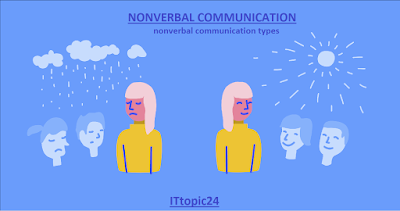NONVERBAL COMMUNICATION
Ø
Verbal communication means with
words; spoken or written syllables
Ø
Nonverbal communication means
without words and we communicate nonverbally as well
Ø
Actually verbal and nonverbal
communication goes along with each other. They support each other to make
communication effective
Ø
It is true that sometimes nonverbal
messages contradict verbal messages
Ø
In fact, sometimes they express more
accurate feelings than spoken or written language
Ø The nonverbal message holds a greater
percentage ineffective messages
u Overview of nonverbal communication
Ø
Three main categories of nonverbal
communication are:
Ø
Appearance
Ø
Body language
Ø
Silence, time, and space
u Appearance communicates….
Ø Before
reading or hearing a verbal message, its appearance will convey nonverbal
impressions which will affect receiver’s attitude
Ø While
sending a letter, the appearance of envelop, font size, correctness of medium
all will convey nonverbal messages
u Effect on oral messages
u Nonverbal
messages will be sent by the person’s personal appearance during speaking
u Dressing,
neatness, occupation, age, nationality,
u Appearance
of surrounding also communicates during a communication process
u Location,
room size, wall decorations, etc.
u Body language communicates…
Ø The
aspects that are included in body language are:
Ø Facial
expressions, gestures, postures, movement, smell and touch, voice and sound
u Eyes and face communicate nonverbally
Ø Eyes
and face are very helpful means of communicating nonverbally
Ø They
can tell about our hidden emotions and feelings
Ø For
example, joy, surprise, anger, confusion, fear, enthusiasm, etc.
u Gestures, postures, and movement
Ø The gesture is a movement of part of
the body, especially a hand or the head, to express an idea or meaning. For example,
“He made a gesture of apology “
Ø
Posture is the carriage of the body
as a whole, the attitude of the body, or the position of the limbs (the arms
and legs).
Ø Posture is how you hold your
body. There are two types:
Dynamic posture is how
you hold yourself when you are moving, like when you are walking, running, or
bending over to pick up something. Static posture is how you hold yourself when you are not moving,
like when you are sitting, standing, or sleeping.
Ø Movement, or motion, is the state of changing
something's position—that is, changing where something is. A flying bird or a
walking person are moving, because they change where they are from one place to
another.
Ø
In many jobs our gestures are
counted more than words
Ø
Deaf people communicate with the
language composed of hand, finger, and eye movements
Ø
But we should not forget that
gestures and movements are culture-specific
Ø
Anger can be expressed through
different gestures
Handshakes reveal attitude by their firmness and limpness...
 |
| NONVERBAL-COMMUNICATION |
WRITTEN BY: MUHAMMAD AJMAL KEERIO.
EMAIL: ajmalkeerio55@gmail.com.






2 Comments
thk a
ReplyDeletethanks for comments... tary blog da suna
Delete